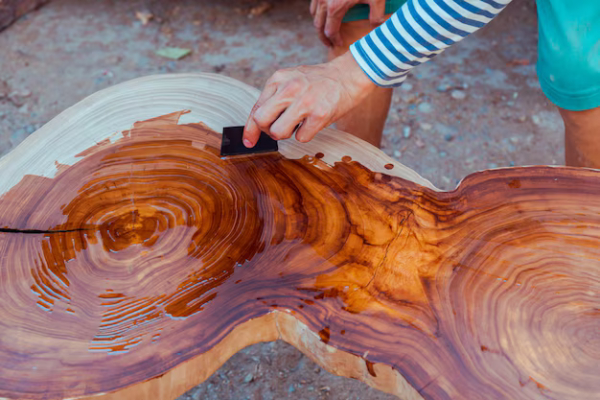Key Takeaways: Linseed Oil on Wood
Linseed oil has been used on wood for hundreds of years, and it’s still one of the most talked-about natural finishes today. But how good is it for your furniture, trim, or woodworking projects? Are there better options out there?
Linseed oil has real strengths, but also some drawbacks that you’ll want to know before using it. This guide breaks down how it works, when to use it, when to avoid it, and how to get the best results.

Flax Seeds Used to Make Linseed Oil for Wood Finishing
Flax seeds are pressed to create linseed oil, a traditional finish for enhancing wood grain.
What Is Linseed Oil and How Does It Work on Wood?
Linseed oil comes from the seeds of the flax plant. When applied to wood, it soaks into the surface, filling pores and highlighting the natural grain. Instead of creating a hard, shiny layer like polyurethane, it leaves the wood looking warm, natural, and slightly richer.
There are two main types of linseed oil you’ll see:
The Benefits of Using Linseed Oil on Wood
Linseed oil is very much a go-to option for both woodworkers and homeowners. One of the biggest reasons for this is its ability to bring out the natural beauty of wood. When applied, it penetrates deep into the fibers and creates a warm appearance that highlights the grain in a way few finishes can easily match.
It’s also easy to use. You don’t need special tools or advanced skills to get a professional-looking result. A rag, a brush, and a little patience are usually all it takes. And compared to many synthetic finishes, linseed oil is affordable and widely available.
Here are the key benefits people value most:
Drawbacks You Should Know Before Using Linseed Oil
Linseed oil isn’t perfect, and it’s important to know where it falls short. The most common complaint from many its is drying time. Raw linseed oil can take weeks to cure. Even boiled linseed oil requires at least a full day between coats.
Another factor is maintenance. Linseed oil doesn’t form a protective shell like polyurethane. It soaks in and needs to be refreshed every year or two. Over time, it can also darken the wood. This may or may not fit the look you’re going for.
To summarize the main limitations:
Best Uses for Linseed Oil on Wood
Linseed oil really performs well in projects that benefit from a natural finish. It’s wise to use for furniture that doesn’t see a lot of wear, such as accent tables, chairs, or decorative shelving. It’s also great for wooden tool handles, since the oil strengthens the fibers and adds grip.
Architectural details like interior trim and moldings also respond well to linseed oil. The finish provides warmth and doesn’t overpower the wood’s natural look. For smaller projects, linseed oil adds a professional touch with complicating things too much.
👉 Keep in mind one important caution: food-contact items like cutting boards or butcher blocks should only be treated with raw, food-grade linseed oil (often sold as flaxseed oil). Never use boiled linseed oil on kitchenware.

Applying Linseed Oil to a Wooden Table for a Smooth Finish
A woodworker applies linseed oil to a table, showing how the oil penetrates and enriches the grain.
When Not to Use Linseed Oil
Linseed oil does have limits, and it’s not the right solution in every situation. If the wood is already sealed with polyurethane, varnish, or paint, the oil can’t penetrate and will just leave a sticky layer on top.
It’s also not a good choice for any wet environments. Bathrooms, kitchen counters near sinks, or outdoor decks will break down quickly if finished with linseed oil alone. For floors or dining tables, linseed oil simply can’t provide the level of durability people expect.
In those cases, a harder finish like polyurethane, varnish, or tung oil will serve you better.
How to Apply Linseed Oil to Wood
Applying linseed oil is pretty straightforward, but there are a few steps that make the difference between a sticky mess and a smooth finish. One of the main keys is to work in thin layers and give the oil enough time to cure, as mentioned earlier.
Below is a simple process to follow. It doesn’t require expensive tools, but patience and proper drying time are essential.
- 1Prep the surface. Sand lightly to open the grain, then wipe away any remaining dust.
- 2Apply the oil. Use a clean rag or brush and spread a thin, even coat.
- 3Let it soak. Give the wood 15–30 minutes to absorb the oil.
- 4Wipe off excess. Any oil left on the surface will stay tacky.
- 5Allow to dry. Expect 24–48 hours for boiled linseed oil and much longer for raw.
- 6Repeat as needed. Multiple thin coats build up a richer finish.
- 7Handle rags with care. Oil-soaked cloths can spontaneously combust. Always lay them flat to dry or dispose of them safely.
Linseed Oil vs. Other Wood Finishes
Linseed oil isn’t the only option for finishing wood. It’s worth knowing how it compares to other common choices. Linseed oil will stand out for its affordability, ease of use, and ability to highlight wood grain. But if you need a finish that resists water and wear, another product may be a smarter choice.
Pro Tips for the Best Results
If you decide to use linseed oil, there are a few practical tips that will help you avoid common mistakes.
First, always test on a scrap piece of the same wood before applying it to your main project. Linseed oil has a tendency to darken wood more than expected.
For indoor projects, stick with boiled linseed oil since it dries faster and delivers a smoother finish. When it comes to cutting boards or kitchen utensils, only use raw, food-grade linseed oil. Never use the boiled version.
Finally, remember that linseed oil isn’t permanent. Plan to reapply every year or two to keep the wood looking fresh and protected!
At Arnold Wood Turning, we’ve been crafting custom wood products for over a century, all designed to look their best with a variety of finishes, including linseed oil. If you’re planning your next project, we can provide the high-quality wood pieces that make finishing work simple and effective.
Get in touch today for a free, no-obligation quote on custom wood products built to last!
Frequently Asked Questions (FAQs) for Using Linseed Oil
- All
- Linseed Oil – Application & Maintenance
- Linseed Oil – Performance & Protection
- Linseed Oil – Safety & Usage Limits
Yes. Oil-soaked rags can spontaneously combust if bunched up. Always lay them flat to dry or dispose of them safely.
No. If the surface has polyurethane, varnish, or paint, linseed oil won’t soak in and will stay sticky.
Only raw, food-grade linseed oil (often labeled as flaxseed oil) is safe for cutting boards and kitchenware. Boiled linseed oil is not safe for food contact.
Most projects do best with 2–3 thin coats, applied with drying time between each.
Boiled linseed oil usually dries in 24–48 hours. Raw linseed oil can take weeks to fully cure.
Every 12–24 months is typical. Items like tool handles may need it more often.
Yes. It typically darkens the wood and adds an amber tone.
Not very well. It soaks into the wood but doesn’t form a hard layer like polyurethane.
No. Linseed oil adds moisture resistance, but it doesn’t make wood fully waterproof. For outdoor or high-moisture areas, you’ll need a stronger finish like varnish or polyurethane.
